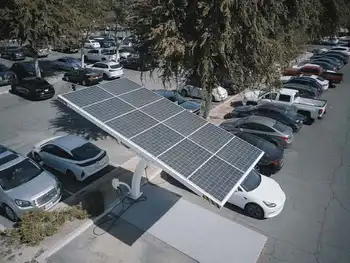Heating a home with a hairdryer
By Globe and Mail
Substation Relay Protection Training
Our customized live online or in‑person group training can be delivered to your staff at your location.

- Live Online
- 12 hours Instructor-led
- Group Training Available
Come this winter, Mr. Braden predicts he'll be warm and toasty in a house that doesn't have a furnace. He plans to keep it warm at practically no cost, relying mainly on sunlight streaming through his bank of south-facing windows to heat the place, and perhaps a little help from the waste heat from appliances such as hair dryers.
"Do I think this house absolutely needs no furnace and could easily heat with either a hair dryer or 10 light bulbs?" he asks. "Absolutely I do."
Mr. Braden, a former municipal politician and retired home builder, is part an emerging trend, the next frontier in residential construction beyond R-2000 homes, the current gold standard for energy-sipping housing in Canada.
Mr. Braden has built a house that is so airtight and insulated it needs next to no heating. The house is so efficient, he claims, that it "doesn't make any sense" to spend $4,000 on a furnace. So he didn't. He hasn't bothered to connect to the grid either, and meets electricity needs with a wind turbine and solar panels in his side yard.
He's not alone. Across the country, a slew of homes have recently been built or renovated that are exploring the outer limits of conservation. Some, like Mr. Braden's, aren't hooked up to the power grid. Others have been designed to use fuel so sparingly and produce some of their own that they're known as "net-zero energy homes," making as much power as they consume.
Although these net-zero houses occasionally draw power from the grid, they are able to get by most of the time using only photovoltaic panels or backyard wind turbines. When it's windy or especially sunny they pump what is surplus to the home's needs back onto the lines, offsetting the energy used from natural gas and balancing out power needs to zero.
"It's the next step on the green building continuum," contends Gordon Shields, executive director of Net-Zero Energy Home Coalition, an Ottawa-based industry group, of this type of housing.
Homes that apply extreme conservation principles also seem to be moving away from their former preserve as a rural fringe activity by back-to-the-land types or extreme environmentalists.
Canada Mortgage and Housing Corp., for instance, recently held a design competition for a dozen homes that use little or no outside energy. One of those chosen was about as far from being rural as possible: an old Second World War house near downtown Toronto that has been so well insulated, among other steps, that its owner no longer pays utility bills. The revenue from the sale of electricity from its solar voltaic panels covers its natural gas bills, which are estimated at only $300 a year.
The federal government and construction industry are also promoting an ambitious goal of having 40,000 zero-energy homes built between now and 2018, according to Doug Tarry, a St. Thomas home builder who is involved with the Industry Canada and Natural Resources Canada objective.
Currently, the homes are at the demonstration stage, making them costly and unaffordable, except for the well heeled. The Toronto CMHC renovation cost about $85,000, to achieve a $1,000 cut in gas bills and a 60-per-cent cut in electricity use, but the hope is that economies of scale will eventually bring expenses down.
If these homes become more common, it could have a major environmental impact, given that about a sixth of Canada's greenhouse gases come from residences and a drafty older home can have carbon dioxide emissions of 10 tonnes a year, double what spews from the average car.
Homes are such energy guzzlers because they're not airtight. They're typically so full of cracks they replace all their inside air with cold outside air at the rate of four to five complete exchanges every hour, forcing furnaces into overdrive.
At the front line of this housing change are people like Mr. Braden, 58, who says he believes he has one of the most energy-efficient homes ever built in Canada.
He is on a personal mission to show it's possible to tweak a normal-looking house and turn it into an energy-saving showcase. To that end, he hasn't been shy about what he's done, and has opened his new home, located in rolling farmland about 20 kilometres west of Hamilton, to free tours. He estimates that more than 1,300 people have taken a look.
In many ways, it's a typical new house, with such normal amenities as a microwave, wooden countertops and maple flooring. Common to many airtight homes, it has a heat-recovery ventilator that takes stale indoor air and uses it to pre-heat incoming fresh air from outside.
He also has a fireplace insert, but doesn't expect to burn more wood in winter than what could be carried on the back of a pick-up truck.
Mr. Braden says he deliberately chose familiar construction techniques and items in his home to avoid the image of being an "envirofreak," those with house features like composting toilets, geodesic architecture and such like that are too far from what is considered normal to be of practical use to others. "I don't want to be conveyed as a hippie. I want to get the message to the mainstream. People need to know that in fact there is a great solution sitting right in front of us," he said .
Before touring his house recently, he told a visitor: "You will be, the word I use is underwhelmed, because there is nothing here you haven't seen most every day."
Certainly, there is nothing out of the ordinary from the outside. The house has a faux log cabin look with thin slabs of wide-cut white pine, separated by off-white chinking, that blends well in this rural neighbourhood of older houses.
At the heart of Mr. Braden's super-efficient home are close attention to the house's vapour barrier, thick insulation-packed walls and the right amount of south-facing windows to enable him to use free sunshine as a heat source, but not so many that the house cooks in summer.
He's worked out a passive solar-heating formula that for every 100 square feet of interior floor space, he needs six to eight square feet of south-facing windows. On the three other sides of the house, windows are used more sparingly, to minimize heat losses. On the south exposure, he has a wide second-storey overhang that shields the house from the hot summer sun, but doesn't block winter's light.
The exterior wall is slightly more than a foot thick, composed of two separated stud walls allowing for three layers of insulation. This packs two and a half times the heat-trapping R-value of standard homes. The concrete basement walls and floor slab are also insulated. For a 1,500 sq. ft. home, the extra insulation added about $12,000 in costs, but eliminated the cost of a furnace, humidifier and air conditioner, while adding only the expense of an air exchanger.
But the most important energy-saving feature, according to Mr. Braden, is that his home is extremely airtight because he placed the vapour barrier on the inside of his interior wall, behind a layer of insulation, rather than just behind the drywall, the current standard practice.
This kept the vapour barrier intact, and not perforated by drywall screws and electrical boxes. Because there is another wall with insulation beyond the vapour barrier, he doesn't think he'll have condensation problems. He also caulked loose ends of the vapour barrier to further block air infiltration.
He says builders and home owners spend too much time worrying about the cosmetic appearance of a house, and not enough attention to what is hidden away in walls.
Mr. Braden thinks governments could adapt his construction technique to social housing, and free low-income earners from utility bills. The extra-thick walls and vapour barrier might add $5,000 per unit to the cost of a row house, but he said body heat from residents and waste heat from lights and appliances would be enough to keep the houses warm, without a furnace.
Because he wanted to live without accessing the electricity grid, Mr. Braden did spend $42,000 on his solar panels and wind turbine, an expenditure he confesses "is a little bit over the top," but his high-efficiency house doesn't rely on them.
The efforts to build houses that don't need outside energy are being watched intently by conservation experts, who say they could hold promise. They're at the "demonstration stage now, very definitely, and I think we'd all be fascinated and delighted to see if it could become mainstream," comments Peter Love, the Ontario government's top energy conservation official.
House builder David Braden says the home he has built near Hamilton is one of the most energy efficient in Canada. Mr. Braden says its triple-insulated 12-inch-thick walls and unique vapour barrier will allow him to keep his home warm this winter without a furnace.
An overhang shades the west-facing side, keeping the house cool in summer.
Windows on the south-facing side are equal to 6 to 8 per cent of the floor space.
The south-side overhang has been designed to shade the lower windows in summer to prevent overheating while allowing lots of winter light.
A heat-recovery ventilator provides fresh air without wasting energy.
Electricity generated by a wind turbine and solar panels feeds a bank of batteries in the basement. When the batteries are fully charged, excess energy is diverted to a ceramic pad that heats the basement floor.











